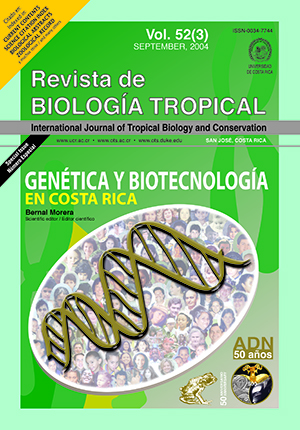Resumen
Banda 3 (AE1) es una de las proteínas más abundantes de la membrana del eritrocito humano. Ésta funciona como un intercambiador aniónico cloruro / bicarbonato y es el punto de anclaje de varias proteínas del citoesqueleto del eritrocito. Se han descrito varias mutaciones y muchas variantes polimórficas se han asociado a esferocitosis hereditaria. La identificación de un marcador genético en el extremo 5’ del gene AE1 podría asociarse a varios defectos moleculares del eritrocito. Este marcador genético es un fragmento de restricción de longitud polimórfica “RFLP” producido por la endonucleasa de restricción Pst I. Se analizaron para este polimorfismo un total de 216 individuos de siete poblaciones: una hispanomestiza (Valle Central), dos afrodescendientes (Limón y Guanacaste) y cuatro amerindias (bribri, cabecar, maleku y guaymí). El alelo más frecuente en la población hispanomestiza fue el 2, mientras en los grupos afrodescendientes y amerindios se encontró el 1. No se observaron diferencias significativas con respecto al equilibrio de Hardy-Weinberg en seis de las poblaciones, sin embargo, el grupo Guaymí si presenta diferencias significativas con respecto al equilibrio de Hardy-Weinberg.Citas
Berne, R.M. & M.N. Levy. 1993. Physiology. Mosby-Year Book, St Louis, Missouri. U.S.A. pp. 20-21
Bruce, L.J., R. Unwin, O. Wrong & M. Tanner. 1998. The association between familial distal renal tubular acidosis and mutations in the red cell anion exchanger (band 3, AE1) gene. Biochem. Cell. Biol. 76: 723-728.
Delaunay, J. 1995. Genetic disorders of the red cell membrane. Critical Reviews in Oncology/Hematology 19: 79-110.
Jarolim, P., J. Palek, H.L. Rubin, J.T. Prchal, C. Korsgren & C.M. Cohen. 1992. Band 3 Tuscaloosa: Pro327ÆArg 327. Substitution in the Cytoplasmic
Domain of Erythrocyte Band 3 Protein Associated with spherocytic Hemolytic Anemia and PartialDeficiency of Protein 4.2. Blood 80: 523-529.
Jarolim, P., H.L. Rubin & S. Zhai. 1992. Band 3 Memphis: A Widespread polimorphism with abnormal electrophoretic mobility of erythrocyte Band 3 protein caused by substitution AAGÆGAG (Lys ÆGlu) in codon 56. Blood 80: 1592-1598.
Jay, L. 1986. Structural aspects of the Red Cell Anion Exchange Protein. Ann. Rev. Biochem. 55: 511-538.
Jenkins, P.B., P.G. Gaallagher & B.G. Forget. 1993. Analysis of a Pst I polymorphism of the human erythrocyte band 3 gene (EPB3). Br. J. Haem. 85: 816-818.
Lux, S.E., K.M. John, R. Kopito & H. Lodish. 1989. Cloning and characterization of Band 3, the human erythrocyte anion-exchange protein (AE1). Proc.
Nath. Acad. Sci. USA. 86: 9093.
Mailet, P., A. Valier & W.H. Reinhart. 1995. Band 3 Chur: and variant associated with band 3- deficient hereditary spherocytososis and substitution in a highly conserved position of transmembrane segment 11. Br. J. Haem. 91: 804-810.
Marguerite, M., B. Kay, J. Hughes, I. Zagon & Lin. 1991. Brain Membrane protein Band 3 performs the same Functions as Erithrocyte Band 3. Cell 88: 2778- 2782.
Miller, S.A., D. Dykes & H.F. Polesky. 1988. Asimple salting out procedure for extracting DNA from human nucleated cell. Nucleic Acid Res. 16: 1215.
Morera, B. & R. Barrantes. 1995. Genes e historia: el mestizaje en Costa Rica. Revista de Historia 32: 43-64.
Morera, B., R. Marín-Rojas & R. Barrantes. 2001. Análisis de varios marcadores genéticos clásicos en la población de Costa Rica. Rev. Biol. Trop. 49: 1237-1252.
Morera, B., R. Marín-Rojas & R. Barrantes. 2003. Gene Admixture in the Costa Rican Population. Ann. Hum. Genet. 67: 71-80.
Palek, J. & S. Lambert. 1990. Genetics of the Red Cells Membrane Skeleton. Sem. Hematology 27: 290-332
Sáenz, G.F., G. Arroyo, J. Jiménez, A. Gutiérrez, M. Barrenechea, E. Brilla & E. Valenciano. 1971. Investigación de hemoglobinas anormales en la población de raza negra costarricense. Rev. Biol. Trop. 19: 251-260.
Sáenz, G.F., G. Arroyo, M.A. Alvarado, G. Montero, J. Jiménez & E. Valenciano. 1974. Hemoglobinas anormales en una población estudiantil universitaria.
Rev. Biol. Trop. 21: 417-424.
Sáenz, G., M. Cháves & E.M. Quintana. 1986. Las hemoglobinopatias en Costa Rica aspectos históricos, culturales y epidemiológicos. Rev. Cost. Cien. Med. 7: 95-106.
Showe, L.C., M. Ballantine & K. Huebner. 1987. Localization of the gene for the erythroid exchage protein, Band 3 (EPB3) to the chromosome 17. Genomics 1: 71-76.
Stewart, E.A., R. Kopito & A.M. Bowcock. 1989. A Pst I polymorphism for the erythrocyte surface protein band 3 (EPB3) to human Chromosome 17. Genomics 1: 71-76.
Yannoukakos, D., C. Vasseur & C. Driancourt. 1991. Human Erithrocyte Band 3 polymorphism (Band 3 Memphis): Characterization of the Structural modification. (Lys 56ÆGlu ) by Protein Chemistry methods. Blood 78: 1117-1120.
##plugins.facebook.comentarios##

Esta obra está bajo una licencia internacional Creative Commons Atribución 4.0.
Derechos de autor 2004 Revista de Biología Tropical


